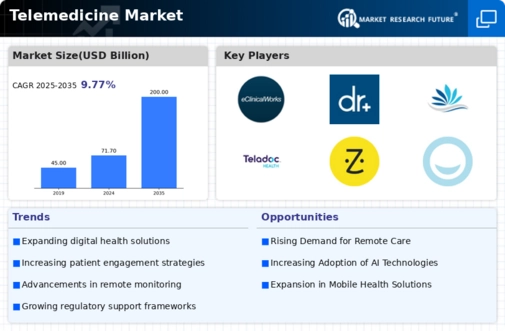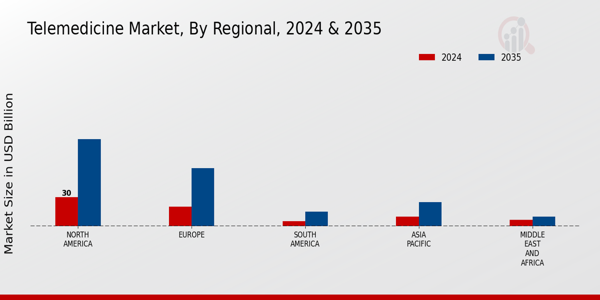Real-time Consultation
Remote Patient Monitoring
Store-and-Forward Telemedicine
Mobile Health Applications
Video Conferencing
Mobile Health Applications
Web-based Platforms
Wearable Devices
Hospitals
Private Practices
Home Care Settings
Healthcare Institutions
Emergency Services
Psychiatry
Dermatology
Pediatrics
North America
Europe
South America
Asia Pacific
Middle East and Africa
North America Outlook (USD Billion, 2019-2035)
North America Telemedicine Market by Service Type
Real-time Consultation
Remote Patient Monitoring
Store-and-Forward Telemedicine
Mobile Health Applications
North America Telemedicine Market by Technology Type
Video Conferencing
Mobile Health Applications
Web-based Platforms
Wearable Devices
North America Telemedicine Market by End User Type
Hospitals
Private Practices
Home Care Settings
Healthcare Institutions
North America Telemedicine Market by Specialty Type
Emergency Services
Psychiatry
Dermatology
Pediatrics
North America Telemedicine Market by Regional Type
US
Canada
US Outlook (USD Billion, 2019-2035)
US Telemedicine Market by Service Type
Real-time Consultation
Remote Patient Monitoring
Store-and-Forward Telemedicine
Mobile Health Applications
US Telemedicine Market by Technology Type
Video Conferencing
Mobile Health Applications
Web-based Platforms
Wearable Devices
US Telemedicine Market by End User Type
Hospitals
Private Practices
Home Care Settings
Healthcare Institutions
US Telemedicine Market by Specialty Type
Emergency Services
Psychiatry
Dermatology
Pediatrics
CANADA Outlook (USD Billion, 2019-2035)
CANADA Telemedicine Market by Service Type
Real-time Consultation
Remote Patient Monitoring
Store-and-Forward Telemedicine
Mobile Health Applications
CANADA Telemedicine Market by Technology Type
Video Conferencing
Mobile Health Applications
Web-based Platforms
Wearable Devices
CANADA Telemedicine Market by End User Type
Hospitals
Private Practices
Home Care Settings
Healthcare Institutions
CANADA Telemedicine Market by Specialty Type
Emergency Services
Psychiatry
Dermatology
Pediatrics
Europe Outlook (USD Billion, 2019-2035)
Europe Telemedicine Market by Service Type
Real-time Consultation
Remote Patient Monitoring
Store-and-Forward Telemedicine
Mobile Health Applications
Europe Telemedicine Market by Technology Type
Video Conferencing
Mobile Health Applications
Web-based Platforms
Wearable Devices
Europe Telemedicine Market by End User Type
Hospitals
Private Practices
Home Care Settings
Healthcare Institutions
Europe Telemedicine Market by Specialty Type
Emergency Services
Psychiatry
Dermatology
Pediatrics
Europe Telemedicine Market by Regional Type
Germany
UK
France
Russia
Italy
Spain
Rest of Europe
GERMANY Outlook (USD Billion, 2019-2035)
GERMANY Telemedicine Market by Service Type
Real-time Consultation
Remote Patient Monitoring
Store-and-Forward Telemedicine
Mobile Health Applications
GERMANY Telemedicine Market by Technology Type
Video Conferencing
Mobile Health Applications
Web-based Platforms
Wearable Devices
GERMANY Telemedicine Market by End User Type
Hospitals
Private Practices
Home Care Settings
Healthcare Institutions
GERMANY Telemedicine Market by Specialty Type
Emergency Services
Psychiatry
Dermatology
Pediatrics
UK Outlook (USD Billion, 2019-2035)
UK Telemedicine Market by Service Type
Real-time Consultation
Remote Patient Monitoring
Store-and-Forward Telemedicine
Mobile Health Applications
UK Telemedicine Market by Technology Type
Video Conferencing
Mobile Health Applications
Web-based Platforms
Wearable Devices
UK Telemedicine Market by End User Type
Hospitals
Private Practices
Home Care Settings
Healthcare Institutions
UK Telemedicine Market by Specialty Type
Emergency Services
Psychiatry
Dermatology
Pediatrics
FRANCE Outlook (USD Billion, 2019-2035)
FRANCE Telemedicine Market by Service Type
Real-time Consultation
Remote Patient Monitoring
Store-and-Forward Telemedicine
Mobile Health Applications
FRANCE Telemedicine Market by Technology Type
Video Conferencing
Mobile Health Applications
Web-based Platforms
Wearable Devices
FRANCE Telemedicine Market by End User Type
Hospitals
Private Practices
Home Care Settings
Healthcare Institutions
FRANCE Telemedicine Market by Specialty Type
Emergency Services
Psychiatry
Dermatology
Pediatrics
RUSSIA Outlook (USD Billion, 2019-2035)
RUSSIA Telemedicine Market by Service Type
Real-time Consultation
Remote Patient Monitoring
Store-and-Forward Telemedicine
Mobile Health Applications
RUSSIA Telemedicine Market by Technology Type
Video Conferencing
Mobile Health Applications
Web-based Platforms
Wearable Devices
RUSSIA Telemedicine Market by End User Type
Hospitals
Private Practices
Home Care Settings
Healthcare Institutions
RUSSIA Telemedicine Market by Specialty Type
Emergency Services
Psychiatry
Dermatology
Pediatrics
ITALY Outlook (USD Billion, 2019-2035)
ITALY Telemedicine Market by Service Type
Real-time Consultation
Remote Patient Monitoring
Store-and-Forward Telemedicine
Mobile Health Applications
ITALY Telemedicine Market by Technology Type
Video Conferencing
Mobile Health Applications
Web-based Platforms
Wearable Devices
ITALY Telemedicine Market by End User Type
Hospitals
Private Practices
Home Care Settings
Healthcare Institutions
ITALY Telemedicine Market by Specialty Type
Emergency Services
Psychiatry
Dermatology
Pediatrics
SPAIN Outlook (USD Billion, 2019-2035)
SPAIN Telemedicine Market by Service Type
Real-time Consultation
Remote Patient Monitoring
Store-and-Forward Telemedicine
Mobile Health Applications
SPAIN Telemedicine Market by Technology Type
Video Conferencing
Mobile Health Applications
Web-based Platforms
Wearable Devices
SPAIN Telemedicine Market by End User Type
Hospitals
Private Practices
Home Care Settings
Healthcare Institutions
SPAIN Telemedicine Market by Specialty Type
Emergency Services
Psychiatry
Dermatology
Pediatrics
REST OF EUROPE Outlook (USD Billion, 2019-2035)
REST OF EUROPE Telemedicine Market by Service Type
Real-time Consultation
Remote Patient Monitoring
Store-and-Forward Telemedicine
Mobile Health Applications
REST OF EUROPE Telemedicine Market by Technology Type
Video Conferencing
Mobile Health Applications
Web-based Platforms
Wearable Devices
REST OF EUROPE Telemedicine Market by End User Type
Hospitals
Private Practices
Home Care Settings
Healthcare Institutions
REST OF EUROPE Telemedicine Market by Specialty Type
Emergency Services
Psychiatry
Dermatology
Pediatrics
APAC Outlook (USD Billion, 2019-2035)
APAC Telemedicine Market by Service Type
Real-time Consultation
Remote Patient Monitoring
Store-and-Forward Telemedicine
Mobile Health Applications
APAC Telemedicine Market by Technology Type
Video Conferencing
Mobile Health Applications
Web-based Platforms
Wearable Devices
APAC Telemedicine Market by End User Type
Hospitals
Private Practices
Home Care Settings
Healthcare Institutions
APAC Telemedicine Market by Specialty Type
Emergency Services
Psychiatry
Dermatology
Pediatrics
APAC Telemedicine Market by Regional Type
China
India
Japan
South Korea
Malaysia
Thailand
Indonesia
Rest of APAC
CHINA Outlook (USD Billion, 2019-2035)
CHINA Telemedicine Market by Service Type
Real-time Consultation
Remote Patient Monitoring
Store-and-Forward Telemedicine
Mobile Health Applications
CHINA Telemedicine Market by Technology Type
Video Conferencing
Mobile Health Applications
Web-based Platforms
Wearable Devices
CHINA Telemedicine Market by End User Type
Hospitals
Private Practices
Home Care Settings
Healthcare Institutions
CHINA Telemedicine Market by Specialty Type
Emergency Services
Psychiatry
Dermatology
Pediatrics
INDIA Outlook (USD Billion, 2019-2035)
INDIA Telemedicine Market by Service Type
Real-time Consultation
Remote Patient Monitoring
Store-and-Forward Telemedicine
Mobile Health Applications
INDIA Telemedicine Market by Technology Type
Video Conferencing
Mobile Health Applications
Web-based Platforms
Wearable Devices
INDIA Telemedicine Market by End User Type
Hospitals
Private Practices
Home Care Settings
Healthcare Institutions
INDIA Telemedicine Market by Specialty Type
Emergency Services
Psychiatry
Dermatology
Pediatrics
JAPAN Outlook (USD Billion, 2019-2035)
JAPAN Telemedicine Market by Service Type
Real-time Consultation
Remote Patient Monitoring
Store-and-Forward Telemedicine
Mobile Health Applications
JAPAN Telemedicine Market by Technology Type
Video Conferencing
Mobile Health Applications
Web-based Platforms
Wearable Devices
JAPAN Telemedicine Market by End User Type
Hospitals
Private Practices
Home Care Settings
Healthcare Institutions
JAPAN Telemedicine Market by Specialty Type
Emergency Services
Psychiatry
Dermatology
Pediatrics
SOUTH KOREA Outlook (USD Billion, 2019-2035)
SOUTH KOREA Telemedicine Market by Service Type
Real-time Consultation
Remote Patient Monitoring
Store-and-Forward Telemedicine
Mobile Health Applications
SOUTH KOREA Telemedicine Market by Technology Type
Video Conferencing
Mobile Health Applications
Web-based Platforms
Wearable Devices
SOUTH KOREA Telemedicine Market by End User Type
Hospitals
Private Practices
Home Care Settings
Healthcare Institutions
SOUTH KOREA Telemedicine Market by Specialty Type
Emergency Services
Psychiatry
Dermatology
Pediatrics
MALAYSIA Outlook (USD Billion, 2019-2035)
MALAYSIA Telemedicine Market by Service Type
Real-time Consultation
Remote Patient Monitoring
Store-and-Forward Telemedicine
Mobile Health Applications
MALAYSIA Telemedicine Market by Technology Type
Video Conferencing
Mobile Health Applications
Web-based Platforms
Wearable Devices
MALAYSIA Telemedicine Market by End User Type
Hospitals
Private Practices
Home Care Settings
Healthcare Institutions
MALAYSIA Telemedicine Market by Specialty Type
Emergency Services
Psychiatry
Dermatology
Pediatrics
THAILAND Outlook (USD Billion, 2019-2035)
THAILAND Telemedicine Market by Service Type
Real-time Consultation
Remote Patient Monitoring
Store-and-Forward Telemedicine
Mobile Health Applications
THAILAND Telemedicine Market by Technology Type
Video Conferencing
Mobile Health Applications
Web-based Platforms
Wearable Devices
THAILAND Telemedicine Market by End User Type
Hospitals
Private Practices
Home Care Settings
Healthcare Institutions
THAILAND Telemedicine Market by Specialty Type
Emergency Services
Psychiatry
Dermatology
Pediatrics
INDONESIA Outlook (USD Billion, 2019-2035)
INDONESIA Telemedicine Market by Service Type
Real-time Consultation
Remote Patient Monitoring
Store-and-Forward Telemedicine
Mobile Health Applications
INDONESIA Telemedicine Market by Technology Type
Video Conferencing
Mobile Health Applications
Web-based Platforms
Wearable Devices
INDONESIA Telemedicine Market by End User Type
Hospitals
Private Practices
Home Care Settings
Healthcare Institutions
INDONESIA Telemedicine Market by Specialty Type
Emergency Services
Psychiatry
Dermatology
Pediatrics
REST OF APAC Outlook (USD Billion, 2019-2035)
REST OF APAC Telemedicine Market by Service Type
Real-time Consultation
Remote Patient Monitoring
Store-and-Forward Telemedicine
Mobile Health Applications
REST OF APAC Telemedicine Market by Technology Type
Video Conferencing
Mobile Health Applications
Web-based Platforms
Wearable Devices
REST OF APAC Telemedicine Market by End User Type
Hospitals
Private Practices
Home Care Settings
Healthcare Institutions
REST OF APAC Telemedicine Market by Specialty Type
Emergency Services
Psychiatry
Dermatology
Pediatrics
South America Outlook (USD Billion, 2019-2035)
South America Telemedicine Market by Service Type
Real-time Consultation
Remote Patient Monitoring
Store-and-Forward Telemedicine
Mobile Health Applications
South America Telemedicine Market by Technology Type
Video Conferencing
Mobile Health Applications
Web-based Platforms
Wearable Devices
South America Telemedicine Market by End User Type
Hospitals
Private Practices
Home Care Settings
Healthcare Institutions
South America Telemedicine Market by Specialty Type
Emergency Services
Psychiatry
Dermatology
Pediatrics
South America Telemedicine Market by Regional Type
Brazil
Mexico
Argentina
Rest of South America
BRAZIL Outlook (USD Billion, 2019-2035)
BRAZIL Telemedicine Market by Service Type
Real-time Consultation
Remote Patient Monitoring
Store-and-Forward Telemedicine
Mobile Health Applications
BRAZIL Telemedicine Market by Technology Type
Video Conferencing
Mobile Health Applications
Web-based Platforms
Wearable Devices
BRAZIL Telemedicine Market by End User Type
Hospitals
Private Practices
Home Care Settings
Healthcare Institutions
BRAZIL Telemedicine Market by Specialty Type
Emergency Services
Psychiatry
Dermatology
Pediatrics
MEXICO Outlook (USD Billion, 2019-2035)
MEXICO Telemedicine Market by Service Type
Real-time Consultation
Remote Patient Monitoring
Store-and-Forward Telemedicine
Mobile Health Applications
MEXICO Telemedicine Market by Technology Type
Video Conferencing
Mobile Health Applications
Web-based Platforms
Wearable Devices
MEXICO Telemedicine Market by End User Type
Hospitals
Private Practices
Home Care Settings
Healthcare Institutions
MEXICO Telemedicine Market by Specialty Type
Emergency Services
Psychiatry
Dermatology
Pediatrics
ARGENTINA Outlook (USD Billion, 2019-2035)
ARGENTINA Telemedicine Market by Service Type
Real-time Consultation
Remote Patient Monitoring
Store-and-Forward Telemedicine
Mobile Health Applications
ARGENTINA Telemedicine Market by Technology Type
Video Conferencing
Mobile Health Applications
Web-based Platforms
Wearable Devices
ARGENTINA Telemedicine Market by End User Type
Hospitals
Private Practices
Home Care Settings
Healthcare Institutions
ARGENTINA Telemedicine Market by Specialty Type
Emergency Services
Psychiatry
Dermatology
Pediatrics
REST OF SOUTH AMERICA Outlook (USD Billion, 2019-2035)
REST OF SOUTH AMERICA Telemedicine Market by Service Type
Real-time Consultation
Remote Patient Monitoring
Store-and-Forward Telemedicine
Mobile Health Applications
REST OF SOUTH AMERICA Telemedicine Market by Technology Type
Video Conferencing
Mobile Health Applications
Web-based Platforms
Wearable Devices
REST OF SOUTH AMERICA Telemedicine Market by End User Type
Hospitals
Private Practices
Home Care Settings
Healthcare Institutions
REST OF SOUTH AMERICA Telemedicine Market by Specialty Type
Emergency Services
Psychiatry
Dermatology
Pediatrics
MEA Outlook (USD Billion, 2019-2035)
MEA Telemedicine Market by Service Type
Real-time Consultation
Remote Patient Monitoring
Store-and-Forward Telemedicine
Mobile Health Applications
MEA Telemedicine Market by Technology Type
Video Conferencing
Mobile Health Applications
Web-based Platforms
Wearable Devices
MEA Telemedicine Market by End User Type
Hospitals
Private Practices
Home Care Settings
Healthcare Institutions
MEA Telemedicine Market by Specialty Type
Emergency Services
Psychiatry
Dermatology
Pediatrics
MEA Telemedicine Market by Regional Type
GCC Countries
South Africa
Rest of MEA
GCC COUNTRIES Outlook (USD Billion, 2019-2035)
GCC COUNTRIES Telemedicine Market by Service Type
Real-time Consultation
Remote Patient Monitoring
Store-and-Forward Telemedicine
Mobile Health Applications
GCC COUNTRIES Telemedicine Market by Technology Type
Video Conferencing
Mobile Health Applications
Web-based Platforms
Wearable Devices
GCC COUNTRIES Telemedicine Market by End User Type
Hospitals
Private Practices
Home Care Settings
Healthcare Institutions
GCC COUNTRIES Telemedicine Market by Specialty Type
Emergency Services
Psychiatry
Dermatology
Pediatrics
SOUTH AFRICA Outlook (USD Billion, 2019-2035)
SOUTH AFRICA Telemedicine Market by Service Type
Real-time Consultation
Remote Patient Monitoring
Store-and-Forward Telemedicine
Mobile Health Applications
SOUTH AFRICA Telemedicine Market by Technology Type
Video Conferencing
Mobile Health Applications
Web-based Platforms
Wearable Devices
SOUTH AFRICA Telemedicine Market by End User Type
Hospitals
Private Practices
Home Care Settings
Healthcare Institutions
SOUTH AFRICA Telemedicine Market by Specialty Type
Emergency Services
Psychiatry
Dermatology
Pediatrics
REST OF MEA Outlook (USD Billion, 2019-2035)
REST OF MEA Telemedicine Market by Service Type
Real-time Consultation
Remote Patient Monitoring
Store-and-Forward Telemedicine
Mobile Health Applications
REST OF MEA Telemedicine Market by Technology Type
Video Conferencing
Mobile Health Applications
Web-based Platforms
Wearable Devices
REST OF MEA Telemedicine Market by End User Type
Hospitals
Private Practices
Home Care Settings
Healthcare Institutions
REST OF MEA Telemedicine Market by Specialty Type
Emergency Services
Psychiatry
Dermatology
Pediatrics












Leave a Comment